
HMS Danae was a Leander-class frigate of the Royal Navy. She was, like the rest of the class, named after a figure of mythology. Danae was built by Devonport Dockyard. She was launched on 31 October 1965 and commissioned on 10 October 1967.

The Galicia class are two landing platform dock (LPD) ships in service with the Spanish Navy. Built by Navantia at Ferrol, their mission is to carry out amphibious warfare by transporting the bulk of the Infantería de Marina. These ships have both a large helicopter flight deck and a 885-square-metre (9,530 sq ft) well deck for large landing craft, as well as a 1,000-square-metre (11,000 sq ft) space for up to 33 main battle tanks.

The landing craft mechanized (LCM) is a landing craft designed for carrying vehicles. They came to prominence during the Second World War when they were used to land troops or tanks during Allied amphibious assaults.
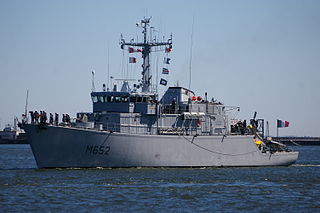
The Tripartite class is a class of minehunters developed from an agreement between the navies of Belgium, France and the Netherlands. A total of 35 ships were constructed for the three navies. The class was constructed in the 1980s–1990s in all three countries, using a mix of minehunting, electrical and propulsion systems from the three member nations. In France, where they are known as the Éridan class they are primarily used as minehunters, but have been used for minesweeping and ammunition transport in Belgium and the Netherlands, where the Tripartites are known as the Alkmaar class.

The Type 025 torpedo boat, also known as the Huchuan or Hu Chwan class, was once the backbone of the People's Liberation Army Navy (PLAN) in its confrontations with its much larger opponents in the Republic of China Navy. Although no longer serving in that capacity, this class is still active. While relatively unsophisticated, the class has enjoyed a longevity in active service thanks to a philosophy within PLAN which has continued to favor its use. Powered by Soviet-era engines, the hydrofoil-equipped boats are capable of 50 knots and carry two torpedo tubes for torpedoes, with some known to be armed with naval mines.
The Type 072 is a class of tank landing ship in the People's Republic of China's People's Liberation Army Navy (PLAN). Seven were built and began entering service by the early-1980s. They replaced American-built LSTs from the Second World War.
The Type 068 and Type 069 are classes of landing craft mechanized (LCM) of the People's Republic of China's People's Liberation Army Navy (PLAN). They may be based on the Soviet T-4 landing craft, or smaller versions of the Type 067 landing craft with shorter tank and longer poop decks. The Type 068 and Type 069 were mainly designed to transport cargo and personnel respectively.
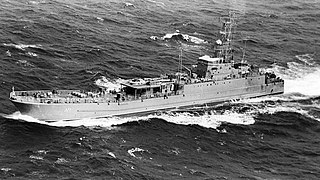
The Polnocny -class ships are amphibious warfare vessels. They were designed in Poland, in cooperation with the Soviet Navy and were built in Poland between 1967 and 2002. They now serve in several different navies, and some have been converted to civilian use. The name comes from the Stocznia Północna shipyard at Gdańsk, where they were built. 107 were built by 1986. In 2002, one ship of a modernised design NS-722 was built in Gdynia for Yemen.
The LCM2000 was a class of Landing Craft Mechanised (LCM) built for the Australian Army by Australian Defence Industries (ADI). The LCMs were ordered in 2001 and the first craft was originally scheduled to enter service with the Army in 2003. The craft proved too large for their intended purpose, however, and were only used for training and minor exercises before the project was cancelled in February 2011.
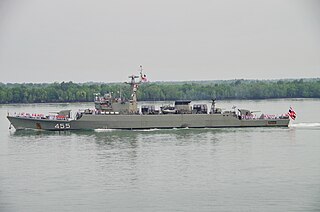
HTMS Chao Phraya (FFG-455) is the lead ship of her class of frigates for the Royal Thai Navy, a variant of the Chinese-built Type 053H2 frigate.

HTMS Kraburi (FFG-457) is the third ship of Chao Phraya-class frigate of the Royal Thai Navy, a variant of the Chinese-built Type 053H2 frigate.
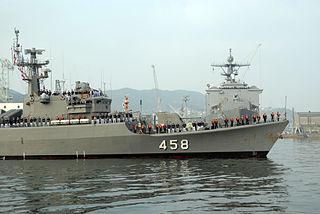
HTMS Saiburi (FFG-458) is the fourth ship of Chao Phraya-class frigate of the Royal Thai Navy, a variant of the Chinese-built Type 053H2 frigate.

JS Chiyoda was a submarine rescue ship of the Japan Maritime Self-Defense Force.
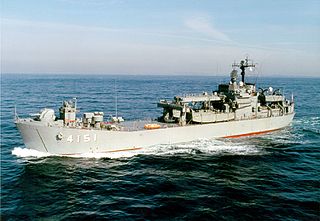
JDS Miura (LST-4151) was the lead ship of the Miura-class landing ship tanks of the Japanese Maritime Self-Defense Force. She was commissioned on 29 January 1975.

JDS Ojika (LST-4152) was the second ship of the Miura-class landing ship tanks of the Japanese Maritime Self-Defense Force. She was commissioned on 22 March 1976.

The Osumi-class tank landing ship were a class of transport ships operated by the Maritime Self-Defense Force. It was recommissioned with the donation of three LST-542 class tank landing ships from the US Navy. Initially, it was categorized as a amphibious landing ship, but the ship type was changed on 1 April 1971.
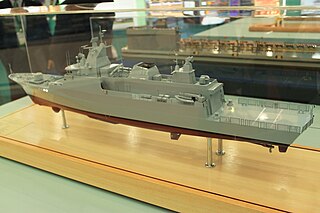
KD Kedah (F171) is the lead ship of Kedah-class offshore patrol vessel of the Royal Malaysian Navy. She was commissioned on 5 June 2006.

KD Perak (F173) is the third ship of Kedah-class offshore patrol vessel of the Royal Malaysian Navy. She was commissioned on 3 June 2009.

KD Terengganu (F174) is the fourth ship of Kedah-class offshore patrol vessel of the Royal Malaysian Navy. She was commissioned on 8 December 2009.

HTMS Bangpakong (FFG-456) is the second ship of Chao Phraya-class frigate of the Royal Thai Navy, a variant of the Chinese-built Type 053H2 frigate.
This page is based on this
Wikipedia article Text is available under the
CC BY-SA 4.0 license; additional terms may apply.
Images, videos and audio are available under their respective licenses.

















